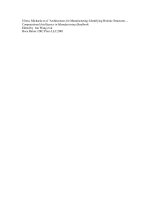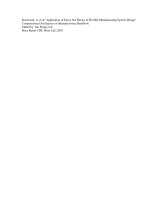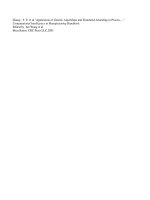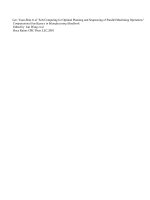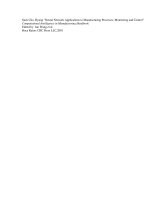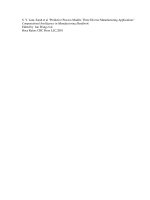Computational Intelligence In Manufacturing Handbook P12
Bạn đang xem bản rút gọn của tài liệu. Xem và tải ngay bản đầy đủ của tài liệu tại đây (2.13 MB, 34 trang )
Suck Cho, Hyung "Neural Network Applications to Manufacturing Processes: Monitoring and Control"
Computational Intelligence in Manufacturing Handbook
Edited by Jun Wang et al
Boca Raton: CRC Press LLC,2001
©2001 CRC Press LLC
12
Neural Network
Applications
to Manufacturing
Processes: Monitoring
and Control
12.1 Introduction
12.2 Manufacturing Process Monitoring and Control
12.3 Neural Network-Based Monitoring
12.4 Quality Monitoring Applications
12.5 Neural Network-Based Control
12.6 Process Control Applications
12.7 Conclusions
12.1 Introduction
The nature of today’s manufacturing systems is changing with greater speed than ever and is becoming
tremendously sophisticated due to rapid changes in their environments that result from customer demand
and reduced product life cycle. Accordingly, the systems have to be capable of responding to the rapid
changes and solving the complex problems that occur in various manufacturing steps. The monitoring
and control of manufacturing processes is one of the important manufacturing step that requires the
capabilities described in the above.
Monitoring of the process state is comprised of three major steps carried out on-line: (i) the process
is continuously monitored with a sensor or multiple sensor; (ii) the sensor signals are conditioned and
preprocessed so that certain features and peaks sensitive to the process states can be obtained; (iii) by
pattern recognition based on these, the process states are identified. Control of the process state is usually
meant for feedback control, and is comprised of the following steps: (i) identifying the dynamic charac-
teristics of the process, (ii) measuring the process state, (iii) correcting the process operation, observing
the resulting product quality, and comparing the observed with the desired quality. It is noted that in
the last step, the observed state needs to be related to product quality.
Normal operation of the above-mentioned steps should not be interrupted and needs to be carried
out with little human intervention, in an unmanned manner if possible. To this end the process with
this capability should be equipped with such functionalities as storing information, reasoning, decision
making, learning, and integration of these into the process. In particular, the learning characteristic is a
unique feature of the ANN. Neural networks are not programmed; they learn by example. Typically, a
Hyung Suck Cho
Korea Advanced Institute of Science
and Technology (KAIST)
©2001 CRC Press LLC
neural network is presented with a training set consisting of a group of examples that can occur during
manufacturing processes and from which the neural network can learn. One typical example is to measure
the quality-related variable of the process state and identify the product quality based on these measured
data. The use of artificial neural networks (ANN) is apparently a good solution to make manufacturing
processes truly intelligent and autonomous. The reason is that the networks possess most of the above
functionalities along with massively computing power.
Utilizing such functionalities, ANNs have quite recently established themselves as the versatile algo-
rithmic and information processing tool for use in monitoring and control of manufacturing process.
In most manufacturing processes, the role of the artificial neural network is to perform signal processing,
pattern recognition, mapping or approximation system identification and control, optimization and
multisensors data fusion
. In more detail, the ANNs being used for manufacturing process applications
are able to exhibit the ability to
1. Generalize the results obtained from known situations to unforeseen situations.
2. Perform classification and pattern recognition from a given set of measured data.
3. Identify the uncertainties associated with the process dynamics.
4. Generate control signal based upon inverse model learning.
5. Predict the quality from the measured process state variables.
Due to such capabilities, there has been widespread recognition that the ANNs are an artificial
intelligence (AI) technique that has the potential of improving the product quality, increasing the effect
events in production, increasing autonomity and intelligence in manufacturing lines, reducing the reac-
tion time of manufacturing systems, and improving system reliability. Therefore, in recent years, an
explosion of interest that has occured in the application of ANNs to manufacturing process monitoring
and control.
The purpose of this chapter is to provide the newest information and state-of-the-art technology in
neural-network-based manufacturing process monitoring and control. Most applications are widely
scattered over many different monitoring and control tasks but, in this chapter, those related to product
quality will be highlighted. Section 12.2 reviews basic concept methodologies, and procedures of process
monitoring and control. In this section the nature of the processes is discussed to give reasons and
justification for applying the neural networks. Section 12.3 deals with the applications of neural networks
in monitoring various manufacturing processes such as welding, laser heat treatment, and PCB solder
joint inspection. Section 12.4 treats neural-network-based control and discusses the architecture of the
control system and the role of the network within the system. Various manufacturing processes including
machining, arc welding, semiconductor, and hydroforming processes are considered for networks appli-
cations. Finally, perspectives of future applications are briefly discussed and conclusions are made.
12.2 Manufacturing Process Monitoring and Control
In this chapter, we will treat the problems associated with monitoring and control of manufacturing
processes but confine ourselves only to product quality monitoring and control problems. Furthermore,
we will consider only on-line monitoring and control schemes.
12.2.1 Manufacturing Process Monitoring
Product quality of most processes cannot be measurable in an on-line manner. For instance, weld
quality in the arc welding process depends on a number of factors such as the weld pool geometry, the
presence of cracks and void, inclusions, oxide films, and the metallographic conditions. Among these
factors, the weld pool geometry is of vital importance, since this is directly correlated to weld strength
of the welded joint. The weld pool size representative of weld strength is very difficult to measure, since
the weld pool formed underneath the weldment surface represents complex geometry and is not exposed
from the outside. This makes it very difficult to assess the weld quality in an on-line manner. Due to this
©2001 CRC Press LLC
reason, direct quality monitoring is extremely difficult. Thus, one needs to resort to finding some process
state variables that can represent the product quality. In the case of arc welding, the representative variable
is the temperature spatially distributed over the weld pool surface, since formation of the weld pool
geometry is directly affected by heat input. In this situation, the weld quality can be indirectly assessed
by measuring the surface temperature.
Two methodologies of assessing product quality, are considered. One is the
direct method
, in which
the quality variables are the monitoring variables. The other is the
indirect method
, which utilizes the
measured state variable as measures of the quality variables. In this case, several prerequisite steps are
required to design the monitoring system, since the relationship between product quality and process
condition is not known
a priori
. In fact, it is very difficult to understand the physics involved with this
issue. The prerequisite steps treat the issues, which include (i) relating the product quality with the process
state variables, (ii) selection of sensors that accurately measure the state variables, (iii) appropriate
instrumentation, and (iv) correlation of the obtained process state data to quality variables. The procedure
stated here casts itself a heavy burden in monitoring of process condition problem. Once this relationship
is clearly established, the quality monitoring problem can be replaced by a process state monitoring
problem.
Figure 12.1 illustrates the general procedure of evaluating product quality from measurement of process
variables and/or machine condition variables. This procedure requires a number of activities that are
performed by the sensing element, signal interpretation elements, and quality evaluation unit. The sensors
may include multiple types having different principles of measurement or multiples of one type. In using
sensors of different types, sensing reliability becomes very important in synthesizing the information
needed to estimate the process condition or product quality. The reliability may change relative to one
another. This necessitates careful development of a synthesis method. In reality, in almost all processes
whose quality cannot be measured directly, multisensor integration/fusion is vital to characterize the
product quality; for instance weld pool geometry in arc welding, nugget geometry in resistance spot
welding, hardened layer thickness in laser hardening, etc. This is because, under complex physical
processing or varying process conditions, a single sensor alone may not adequately provide the informa-
tion required to make reliable decisions on product quality or process condition. In this case, sensor
fusion or integration is effective, since the confidence level of the information can be enhanced by
fusion/integration of the multiple sensor domain. This multiple sensor approach is similar to the method
a human would use to monitor a manufacturing process by using his own multiple senses, and processing
the information about a variety of state variables that characterize the process. Since measurement of
process variables is performed by several sensing devices, i.e., more sensor-based information is consid-
ered, the uncertainty and randomness involved with the process measurement may be drastically reduced.
The two typical methods used to evaluate product quality handle information differently. One makes
use of the raw signal directly, the other uses features extracted from the raw signal. In the case of using
the raw signal, indicated in a dotted arrow, the amount of data can be a burden on tasks for clustering
and pattern recognition. On the other hand, the feature extraction method is very popular, since it allows
analysis of data in lower dimensional space and provides efficiency and accuracy in monitoring. Usually,
the features are composed of the compressed data due to the reduction of dimensionality, which is
postulated to be much smaller than the dimensionality of the data space. The feature values used could
be of entirely different properties, depending upon monitoring applications. For example, in most
industrial inspection problems adopting machine vision technique, image features such as area, center
of gravity, periphery, and moment of inertia of the object image are frequently used to characterize the
shapes of the object under inspection. In some complicated problems, the number of features used has
to be as many as 20 in order to achieve successful problem solution. On the contrary, in some simple
problems one single feature may suffice to characterize the object. Monitoring the machine conditions
frequently employs time and frequency domain features of the sensor signal such as mean variance,
kurtosis, crest factor, skewness, and power in a specified frequency band.
The selection of features is often not an easy task and needs an expert to work with characteristics of
the signal/data. Furthermore, computation of feature values may often constitute a rather cumbersome
©2001 CRC Press LLC
task. It is therefore important to obtain features that shows high sensitivity to product quality or a quality-
related process variable and low sensitivity to process variation and uncertainty. It is equally important
to obtain the fewest but the best combination of features in order to reduce the computational burden
and increase efficiency in clustering. This can ensure better performance of the monitoring system, while
reducing the monitoring cost.
When the choice of features is appropriately made, and their values are calculated, the next task is to
find the similarity between the feature vector and the quality variables or process conditions, that is, to
perform the classification task. If the feature vector is denoted by
x
, finding the similarity mathematically
is to find the relationship
R
;
R
:
i
(
x
)
~
→
C
(
C
= 1 or 2, or … or, m) Equation (12.1)
where
C
denotes the number assigned specifically to a class category and has
m
categories of classification.
In the above equation, the category number
C
is assumed to be preassigned to represent the quality
FIGURE 12.1
A general procedure for quality monitoring.
sensor 1
sensor 2
sensor n
signals/data
processing
feature extraction
classification
pattern recognition
quality / process
state evaluation
control action
Manufacturing Process
raw signal/data
©2001 CRC Press LLC
variables or process conditions. The operator
i
that yields the relationship expressed in Equation 12.1 is
called the classifier.
A large number of classifiers have been developed for many classification problems. Depending upon
the nature of the problem, the classifier needs to differ in its discriminating characteristics, since there
is no universal classifier that can be effectively used for a large class of problems. In fact, it is observed
from the literature that a specific method works for a specific application. Frequently used conventional
classifiers include K-nearest mean, minimum distance, and the Bayes approach. This topic will be revisited
in detail.
There are several important factors that affect classification accuracy, including the distribution char-
acteristics of data in feature data space, and the degree of similarity between patterns. The set of extracted
features yields the sets of pattern vectors to the classifier, and the vector components then are represented
as the classifier input. The pattern vectors thus formed must be separable enough to discriminate each
pattern that uniquely belongs to the corresponding category. This implies that we compute feature
transformation such that the spread of each class in the output feature space is maximized. Therefore,
the classifier should be designed in such a way that the designed methodology is insensitive to the influence
of the above factors.
12.2.2 Manufacturing Process Control
Most of manufacturing processes suffer from the drawback that their operating parameters are usually
preset with no provision for on-line adjustments. The preset values should be adjusted when process
parameters are subject to change and external disturbances are present, as is usually the case in manu-
facturing process. As discussed previously, the manufacturing process is time-varying, highly nonlinear,
complex, and of uncertain nature. Unlike nonlinearity and complexity, variability and uncertainty can
be decreased if they are the result of some seemingly controllable factors such as incorrect machine
setting, inconsistent material dimension and composition, miscalibration, and degradation of process
machine equipment. Reducing the effect of these factors would improve process conditions, and therefore
product quality. However, these controllable factors usually cannot be measurable in an on-line manner,
and thus these effects cannot be easily estimated. This situation requires on-line adjustment or control
of the operating parameters in response to the environment change, which in turn needs reliable, accurate
models of the processes. This is due to the fact that, unless the process characteristics are exactly known,
the performance of a control system that was designed based on such uncertainty may not be guaranteed
to a satisfactory level.
A general feedback control system consists of a controller, an actuator, a sensor, and a feedback element
that feeds the measured process signal to the controller. The role of the controller is to adjust its command
signal depending upon the error characteristics. Therefore, performance of the controller significantly
affects the overall performance of the control system for the manufacturing process. Equally important
is the performance of the actuator and sensor to be used for control. Unless these are suitably designed
or selected, the control performance would not be guaranteed, even though the controller was designed
in a manner best reflecting the process characteristics.
For controller design of the manufacturing process, the greatest difficulty is that an accurate model
of the process dynamics often does not exist. Lack of the physical models makes the design of a process
controller difficult, and it is virtually impractical to use the conventional control methodologies. In this
situation, these are two widely accepted methods of designing process controllers. One is to approximate
the exact mathematical model dynamics by making some assumptions involved with the process mech-
anism and phenomena. As shown in Figure 12.2, the process model thus approximately obtained can be
utilized for the design of the conventional controllers, which include all the model-based control schemes
such as adaptive, optimal, predictive, robust, and time-delay control, etc. The advantage of the approach
using the model dynamics is that the analytical method in design is possible by enabling us to investigate
the effects of the design parameters. The disadvantage is that the control performance may not be
satisfactory when compared with the desirable performance of the ideal case, since the controller is
©2001 CRC Press LLC
designed based upon an approximate model. Furthermore, when changes in the process characteristics
occur with time, the designed controller may be further deteriorated.
The other widely accepted approach is based on an experimental trial-and-error method that uses
heuristics of human operators rather than a mathematically based algorithm. In this case, human oper-
ators design the controller, making use of their own knowledge and past experience on the control action
based upon observation of dynamic characteristics. The control actions of a human operator are generated
from the inference of rules from which he formulates his knowledge. Accordingly, the performance of
the control largely depends upon how broad and deep his knowledge of the process dynamic characteristic
is and how well he can construct the appropriate rule base utilizing his knowledge and experience. As
can be perceived, reliable control performance may not be guaranteed with a human operator’s obser-
vation and experience alone, when the characteristics of manufacturing processes are uncertain and time-
varying in nature.
12.3 Neural Network-Based Monitoring
In the previous sections we noted that monitoring requires identification or estimation of the character-
istic changes of a manufacturing process based on the evaluation of a process signature without inter-
rupting normal operations. In doing so, a series of tasks is performed, such as signal processing, feature
extraction, feature selection and integration, classification, and pattern recognition. In some cases, a
complete process model describing the functional relationship between process variables must be
extracted. Some typical problems that arise in the conventional monitoring task may be listed as follows:
• Inability to learn and self-organize signals or data
• Inefficiency in solving complex problems
• Robustness problem in the presence of noise
• Inefficiency in handling the large amount of signals/data required
In any process, disturbances of some type arise during manufacturing. For example, in welding
processes, there are usually some variation in incoming material and material thickness, variation in the
wire feeder, variation in gas content, and variation in the operating conditions such as weld voltage and
current. When some of these process parameter changes occur, the result is variation in monitoring
signal. This situation requires adaptation of the monitoring strategy, signal processing, and feature
extraction and selection by analyzing the changes in the signature of the incoming signal and incoming
FIGURE 12.2
A feedback procedure for the design of a process controller.
Mathematical
modeling of
manufacturing
process
Controller
design
Implementation in
physical process
Performance
evaluator
Simulation
of the
control system
Selection of
actuators &
sensors
©2001 CRC Press LLC
information on the observed phenomena. The conventional method, however, cannot effectively respond
to these changing, real process variations. In contrast to this, a neural network has the capability of testing
and selecting the best configuration of standard sensors and signal processing methods. In addition, it
has a learning capability that can adapt and digest changes in the process.
Normally, it is not easy to directly measure product quality from sensors, as mentioned previously.
Indirectly measuring a single measurement may suffice to give some correlation to the quality. However,
the relationship between the quality variables and the measured variables is normally quite complex,
being also subjected to the dependency of some other parameters. Furthermore, in some other cases,
single sensor measurement may not provide a good solution, and thus multiple measurements may be
required. This situation calls for a neural network role that has the capability to self-organize signals or
data and fuse them together.
A robustness problem in the presence of signal noise and process noise is one of the major obstacles
to achieving high quality in monitoring performance. In general, process noise has either long-term or
short-term characteristics. For instance, in machining processes, if vibration from the ground is coming
into the machine processing the materials, and lasts continuously for some time, it can be said to be a
long-term noise. If it continues only for a short time and intermittently, it may be regarded as a short-
term noise. A neural network can handle the short-term noise without difficulty due to its generalization
characteristics; it provides monitoring performance that is almost immune to the process noise. Such a
neural network easily takes the roles of association, mapping, and filtering of the incoming information
on the observed phenomena.
Finally, a monitoring task requires a tremendous amount of signal/data to process. Handling this large
volume of data is not a difficult task for the neural network, since it possesses the capability of a high-
speed paralleled computation. And, if necessary, it has the ability to compress the data in an appropriate
way.
The foregoing discussions imply that the role of networks is to provide generality, robustness, and
reliability to the monitoring. When they are embedded in the monitoring system, the system is expected
to work better, especially under operating conditions with uncertainty and noise. Even in such conditions
the embedded system should be able to effectively extract feature of the measured signals, test and select
the extracted features and, if necessary, integrate them to obtain better correlation to the quality-related
variables. In addition, it should effectively classify the collected patterns and recognize each pattern to
identify the quality variables.
The neural networks often used for monitoring and control purpose are shown in Figure 12.3. In this
figure, the neural networks are classified in terms of the learning paradigm. These different types of the
networks are used according to domain of problem characteristics and application area. Specifically,
problem characteristics to be considered include ability of on-line monitoring, time limitation of classi-
fication and recognition robustness to uncertainty, and range of process operations. Even if one classifier
works well in some problem and/or application area, it may not be effectively applied to some others
because any single network does not process general functionality that can handle all types of complexity
involved with the processes. For this reason, integration of two or more networks has become popular
in monitoring and control of manufacturing processes.
12.3.1 Feature Selection Method
This issue concerns relating the feature vector to classification and recognition. Important input features
can be selected in various ways within the neural network domain. The method introduced herein is
based upon a multilayer perceptron with sigmoidal nonlinearity whose structure is shown in Figure
12.4(a).
The first method [Sokolowski and Kosmol, 1996] utilizes the concept of
weight pruning,
which can
determine the importance of each input feature. The method starts with selection of a certain weight of
an already trained network. This selected weight is then set to zero while the network processes a complete
set of input feature vectors. Due to this change, the error will occur as follows:
©2001 CRC Press LLC
E
s
– for
k
= 1, 2, …
M, j
= 1, 2 …,
N
Equation (12.2)
where the subscript
j
refers to the
j
th
input vector, is the desired output of the
k
th
neuron in the output
layer, is the actual output of the
k
th
neuron for the
j
th
input vector,
M
is the number of the output neurons,
and
N
is the number of input vectors.
If the error does not exceed a prescribed maximum value
E
s
, the contribution of the weight omitted
in the calculation to obtain the actual output is considered to be less important.
For each weight that satisfies
E
k
E
s
the following total RMS error is calculated by
FIGURE 12.3
The neural networks frequently used for classifiers, identifiers, and controllers.
FIGURE 12.4
A discriminant function defined in a two-dimensional space.
Neural Network Classification
Supervised
learning
Unsupervised
learning
Hybrid learning
ART-1,2
Boltzmann
Hopfield
Hamming
Multilayer
perceptron
RBF
High-order neural
network
Neocognitron
Gaussian
mixture
LVQ-2
Kohonen
LVQ-1
K nearest neighbor
PCA
CPN
x
2
x
1
g(x) = 0
~
g(x) > 0
~
g(x) < 0
~
max d
k
j
o
k
j
d
k
j
©2001 CRC Press LLC
Equation (12.3)
After checking this weight its previous value is restored and another weight is tested. The procedure
of weight pruning continues until the elimination of a weight leads to
E
s
error above the prescribed value.
The second method is referred to as weight sum method [Zurada, 1992]. In this method, the sensitivity
of each input feature to total error is evaluated based on the sum of absolute values of the weight, which
is defined by
(
j
=1, 2 …,
N
)
Equation (12.4)
where
j
is the
j
th
input feature, and
w
kj
is the weight parameter related to the
j
th
input. If the sum of the
weight values ||
w
kj
||
is below a prescribed value, the input can be discarded from further consideration,
implying that the important input features can be removed.
12.3.2 Classification Method
With an appropriate set of input feature thus selected, the next task in monitoring is to perform
classification and recognition. The goal of pattern classification is to assign input patterns to partition
the multidimensional space spanned by the selected features into decision regions that indicate to which
any belongs. Good classification performance therefore requires selection of an effective classifier, e.g., a
type of neural network, in addition to selection of effective features. The network should be able to make
good use of the selected features with limited training, memory, and computing power.
Figure 12.3 summarizes various types of neural networks popularly used for pattern classification. The
Hopfield net, Hamming net, and Carpenter–Grossberg classifier have been developed for binary input
classification, while the perceptron, Kohonen self-organizing feature maps, and radial basis function
network have been developed for analog inputs. The training methods used with these neural networks
include supervised learning, unsupervised learning, and hybrid learning (unsupervised + supervised).
In the supervised classifier the desired class for given data is provided by a teacher. If an error in assigning
correct classification occurs, the error can be used to adjust weight so that the error decreases. The
multilayer perceptron and radial basis function classifiers are typical of this supervised learning.
In learning without supervision, the desired class is not known
a priori,
thus explicit error information
cannot be used to adjust network behavior. This means that the network must discover for itself dissim-
ilarity between patterns based upon observation of the characteristics of input patterns. The unsupervised
learning classifiers include the Kohonen feature map, learning vector quantizer with a single layer and
ART-1 and ART-2. Classifiers that employ unsupervised/supervised learning first form clusters by using
unsupervised learning with unlabeled input patterns and then assign labels to the cluster using a small
amount of training input patterns in the supervised manner. The supervised learning corrects the sizes
and locations of the cluster to yield an accurate classification. The primary advantage of this classifier is
that it can alleviate the effort needed to collect input data by requiring a small amount of training data.
The classifiers that belong to this group are the learning vector quantizer (LVQ1 and 2) and feature map.
The role of the neural network classifiers is to characterize the decision boundaries by the computing
elements or neurons. Lippmann [1989] divided various neural network classifiers into four broad groups
according to the characteristics of decision boundaries made by neural network classifiers. The first group
is based on
probabilistic distributions
such as probabilistic or Bayesian classifiers. These types of neural
networks can learn to estimate probabilistic distributions such as Gaussian or Gaussian mixture distri-
butions by using supervised learning. The second group is classifiers with
hyper-plane
decision bound-
E
NM
do
T
k
j
k
j
j
N
k
M
=
()
==
∑∑
1
2
11
–
ww
kj kj
k
M
=
=
∑
1
©2001 CRC Press LLC
aries. Nodes form a weighted sum of the inputs and pass this sum through a sigmoid nonlinearity. The
group includes multilayer perceptrons, Boltzmann machines, and high-order nets. The third group has
complex boundaries that are created from
kernel function
nodes that form overlapping receptive fields.
Kernel function nodes use a kernel function, as shown in the figure, which provides the strongest output
when the input is near a node’s centroid. Kernel function indicates that the node output peaks when the
input is near the centroid of the node and then falls off monotonically as the
Euclidean distance
between
input and the centroid of a node increases. Classifications are made by high-level nodes that form
functions from weighted sums of outputs of kernel function nodes. These type of neural network
classifiers are based on the cerebellar model articulation controller (CMAC), radial basis function clas-
sifier. The fourth group is
exemplar classifiers,
which perform classification based on the identity of the
training examples, or exemplars, that are nearest to the input, similar to the kernel function nodes.
Exemplar nodes compute the weighted Euclidean distance between inputs and node centroids. Centroids
correspond to previously given labeled training examples or to cluster center and called prototypes. These
classifiers includes k-nearest neighbor classifiers, the feature map classifiers, the learning vector quantizer
(LVQ), restricted coulomb energy (RCE) classifiers, and adaptive resonance theory (ART). These four
group classifiers provide similar low error rate. But their characteristics for real world problems are
different.
Let us illustrate the role of the neural network classifier in classification by illustrating a basic classi-
fication problem. Suppose that the input components of a classifier are denoted by an
n
-dimensional
vector
x
. This then can be represented by a point in
n
-dimensional Euclidean space
E''
called pattern
space. An illustration is presented for the case of two-dimensional spaces,
n
= 2, in Figure 12.4.
In the figure,
g(x)
is called the
discriminant function,
which can discriminate the decision boundary.
The function
g(x)
shown here is not a straight line dividing the pattern space, and represents an arbitrary
curved line. This problem is called a n
onlinearly separable classification problem
. The pattern
x
belongs
to the
i
th
category if and only if
Equation (12.5)
Therefore, within the region, the
i
th discriminant function will have the largest value. When a monitoring
problem is complex and highly nonlinear, adaptive
nonparametric
neural network
classifiers
have an
advantage over the conventional methodologies. They take role of determining the decision surface
~
g
(
x
)
in multidimensional space defined by the input feature vectors.
Determining the function depends upon which classifier is used, and which domain of the training
data is considered for classification. Depending upon the problem characteristics and domain, the
classifier, its structure, and the learning algorithm need to be carefully chosen. Once these are chosen,
the next task is to provide the network with the capability of good classifications. To design such a
classifier, the development of neural network classifiers must go through two major phases: training phase
and test phase.
12.4 Quality Monitoring Applications
There have been tremendous research efforts in monitoring of manufacturing processes. A majority of
the research deals with tool condition, machine process condition, and fault detection and diagnosis,
which are not directly related to product quality. In contrast, not many studies deal with product quality
monitoring. This is mainly due to the fact that direct quality monitoring is extremely difficult and that
even correlating the process variables with it is not an easy task. Table 12.1 summarizes types of quality
monitoring in various manufacturing processes, including types of sensor signals, neural networks, and
quality variables used for monitoring. Some neural network applications will be summarized below for
turning end milling, grinding, and spot welding processes.
gx gx ij i j
ij
() ();, , ( )
~~
>=≠12
©2001 CRC Press LLC
12.4.1 Tapping Process
Tapping is an important machining process that produces internal threads and requires relatively low
cutting speed and effective cooling. Several malfunctions may occur in the process, including tap-hole
misalignment, tap wear, tap-hole mismatch. With such malfunctions, the machine produces threads of
undesirable quality such as hole undersize, hole oversize, eccentricity of the hole, and so on. To monitor
TABLE 12.1
Types of Sensor Signals and Neural Networks in Monitoring
Process Sensor Signal Neural Network Quality Variable
Turning Force
Diffraction image
Perceptron
Perceptron
Surface finish
Surface finish
Grinding Image
Wheel velocity grinding, depth
AE
RBF
Perceptron
RBF
Surface finish
Grinding burn
Surface finish
Milling Acoustic wave, spindle
variation, cutting force
Perceptron Surface finish, bore
tolerance
Spot welding Weld resistance
Current
Electrode force
Perceptron
Perceptron
LVQ
Weld nugget geometry
Quality factor
Strength, indentation
Arc welding Weld current
Acoustic wave
Tem perature
Vision image
Welding current,
arc voltage
Ultrasonic sound
Perceptron
Perceptron
Perceptron
Perceptron
Perceptron
Perceptron
Weld pool geometry
Acceptability of weld
Weld pool geometry
Weld pool geometry
Weld pool geometry
Weld defects (void, crack)
Pipe welding Optical image Kohonen Weld pool geometry
PCB solder joint CCD image LVQ Surface dimension
IC fabrication Chamber pressure
DC bias, reflected RF power
Etch time, gas flow rate, RF
power pressure
Perceptron
Perceptron
Perceptron
Plasma etching fault
detection
Oxide thickness
Oxide thickness
Autoclave curing Pressure, the 1st and 2nd
holding temperature
Perceptron Laminate thickness, void
size
Web CCD image LVQ2 Surface roughness
Steel casting Temperature Time-series and spatial Breakout
Steel types inspection Vision (capture of spark) Perceptron Steel types
Metal forging Ram load and velocity Perceptron Final shape, microscopic
properties
Wire EDM Pulse width, wire tension Perceptron Surface roughness
Color printing Color Perceptron Desired color codes
Light wave inspection CCD image Perceptron, counter-
propagation
Light ware defect
Tapping Cutting force Perceptron, RBF Thread quality
Riveting AE Perceptron, Kohonen Crack growth
Laser surface hardening Temperature Perceptron Layer thickness
©2001 CRC Press LLC
these conditions, a network-based monitoring system [Chen et al., 1996] has been developed. This system
utilizes a dynamometer that measures tapping torque, thrust force, and lateral force. The network used
here is composed of
M
subnetworks, as shown in Figure 12.5(a), where
M
denotes the number of
categories to be classified. Each subnetwork is essentially the information-gain-weighted radial basis
function, which accepts an input vector (
x
1
,
x
2
, …
,
x
8
) and produces one output. The input vector
composed of eight nodes of the input layer of the RBF is extracted from the dynamometer, including
x
1
= peak of torque,
x
2
= mean of torque,
x
3
= variance of torque,
x
4
= mean of torque in retraction
stroke,
x
5
= mean of thrust force,
x
6
= covariance of torque and force,
x
7
= correlation of torque and
thrust force,
x
8
= correlation of torque and thrust force in retraction stroke. The
w
i
°
assigned to each
node represents the information gain-weighted value, which is learned based on information available
at the signal/index evaluation stage. The information gains can always be updated when new data are
available. The weight parameters
w
i
°
(
i
= 1, 2
,
…,
N
) are calculated from entropy theory. According
FIGURE 12.5
A neural network schematic proposed for tapping process monitoring. (a) The proposed neural
architecture. (b) Information-gain-weighted RBF as the sub-net.
Input
vector
sub-net 1
sub-net 2
sub-net M
= O
1
: Condition 1 to the degree O
1
= O
2
: Condition 2 to the degree O
2
= O
M
: Condition 1 to the degree O
M
< θ
1
min
: Not Condition 1
< θ
M
min
: Not Condition M
< θ
2
min
: Not Condition 2
(a) The proposed neural architecture
c
1
σ
1
c
2
σ
2
c
j
σ
j
c
J
σ
J
x
1
w
1
w
2
O
1
w
i
w
L-1
w
L
x
i
x
N
w
N
0
w
1
0
desired value
for training d
Input x
(b) Information-gain-weighted RBF as the sub-net
